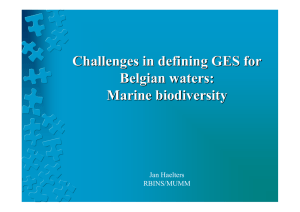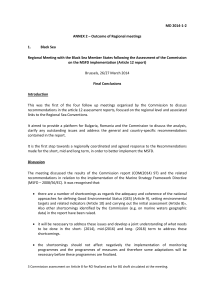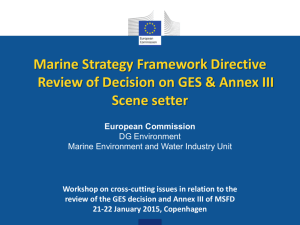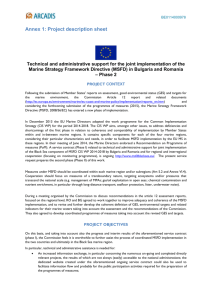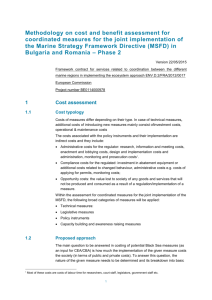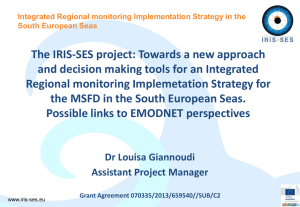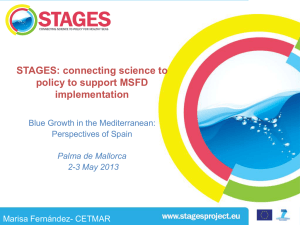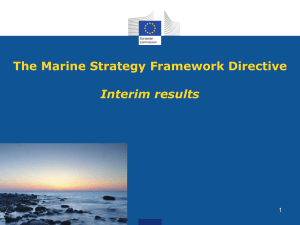Options for delivering ecosystem
advertisement
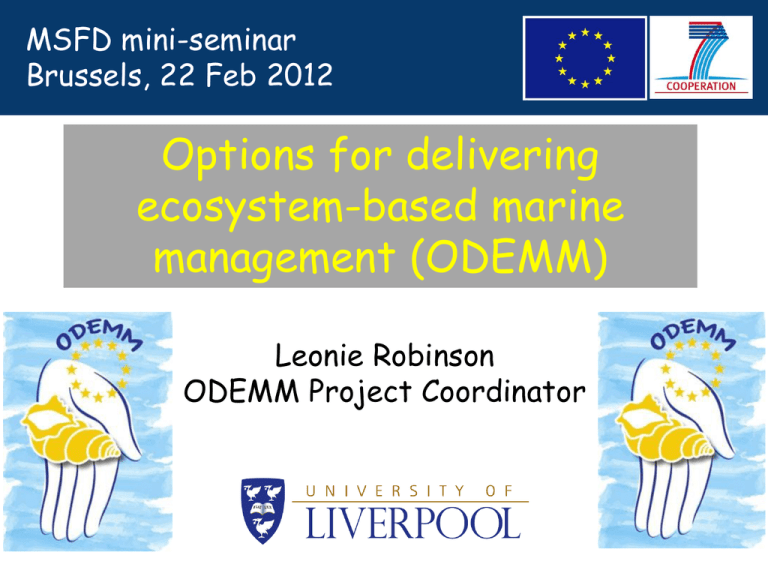
MSFD mini-seminar Brussels, 22 Feb 2012 Options for delivering ecosystem-based marine management (ODEMM) Leonie Robinson ODEMM Project Coordinator 1. Introduction • Title: Options for Delivering Ecosystem-based Marine Management (ODEMM) • Duration & timing: March 2010 - August 2013 • Geographical scope: Europe’s four regional seas • Aim: To develop a set of fully-costed ecosystem management options that would deliver the objectives of the Marine Strategy Framework Directive, the Habitats Directive, the European Commission Blue Book and the Guidelines for the Integrated Approach to Maritime Policy. • Focus: Support implementation of MSFD (and Habs Directive) by developing tools and understanding required to weigh up options by Member States, Regional bodies and the EC Introduction Timeline for MSFD taken from UK perspective (DEFRA) ODEMM 1. Timing affects utility of work to different steps of MSFD implementation 2. Tools developed applicable to any MS or regional assessment Phase 1 Phase 2 TASKS Completed summer 2011 Completed Completed autumn summer 2012 2013 Initial assessment, metadata collation, status and risk to GES (WPs 1 and 3) X Regional governance & legal setting (WP 2) X Descriptor case studies: evaluate management measures against status quo (WP 4) Descriptor case studies: evaluate risks to GES under different scenarios (WP5) Descriptor case studies: costs and benefits of different scenarios (WP6) Elaborate different governance settings to support EA and MSFD implementation (WP7) Implementation plan for delivering MSFD HLOs and toolkit to support decision-making Phase 3 Support MSFD initial assessment process Support Xdevelopment of targets, implementation of X programmes monitoring and selection of X programmes of measures Support Xgeneral implementation of MSFD and scope to achieveX EBM in European regional seas Introduction OUTPUTS: - Toolkit and tested applications of individual tools across regional seas (databases to drive these) - Barriers to implementation of MSFD (and linked policies) and plan for transition to successful implementation www.liv.ac.uk/odemm/Outputs.html Introduction Tools developed tested in all regional seas. Scope and knowledge transfer dependent on: - expertise of partnership -Coverage of MSs and neighbouring countries - links of partners to national administrations and regional bodies - approach of MSs and regional bodies Marine Regions Baltic Sea Mediterranean Sea North East Atlantic Ocean EEZ Boundaries Marine Sub-regions Atlantic Ocean Bay of Biscay & Iberian Coast Celtic Sea Greater north Sea Adriatic Sea Aegean-Levantine Sea Ionian Sea W. Mediterranean Sea 2. Results to date Phase 1 Phase 2 TASKS Completed summer 2011 Completed Completed autumn summer 2012 2013 Initial assessment, metadata collation, status and risk to GES (WPs 1 and 3) X Regional governance & legal setting (WP 2) X Descriptor case studies: evaluate management measures against status quo (WP 4) Descriptor case studies: evaluate risks to GES under different scenarios (WP5) Descriptor case studies: costs and benefits of different scenarios (WP6) Elaborate different governance settings to support EA and MSFD implementation (WP7) Implementation plan for delivering MSFD HLOs and toolkit to support decision-making Phase 3 Support MSFD initial assessment process X development of Support targets, implementation of X monitoring programmes and selection of programmes of measures X Support X general implementation of MSFD and scope to achieve EBM X in European regional seas ODEMM tools: Linkage Framework and Tables ODEMM tools: Linkage Framework and Tables ODEMM tools: Pressure Assessment • Tool to assess threat to ecosystem characteristics (ECs) from different human sectors and their pressures • Can be used to assess threats related to the different GES descriptors • Weights interactions between ECs, pressures and sectors in terms of extent & frequency of overlap, degree of impact (DoI), resilience of EC and persistence of the pressure • Utility to inform selection of management measures Extent/frequency of overlap & DoI – management options Resilience & persistence – management potential • Applied to all regional seas and guidance available online ODEMM tools: GES Risk Assessment • Tool to assess level of risk to individual GES descriptors at time of assessment (low, moderate or high risk) • Risk criteria developed for each descriptor based around definition of GES for descriptors, plus information on indicators and attributes • Methodology developed so that information from relevant existing national and regional assessments could be translated into an initial assessment for GES (rather than assuming they mean the same thing) • Applied to all regional seas and guidance available online Results of ODEMM GES risk assessment Detailed information on each Descriptor per regional sea in ODEMM Deliverable 1 Lessons learnt & future challenges 1. Good to develop methodologies through a research driven process, but will they be used by MSs/regional sea bodies in current cycle of MSFD? How to improve chances of research interacting with actors: • Funders facilitate interactions between relevant actors from call onwards (not once projects already well developed) • Projects develop their contact lists for dissemination but funders could help to direct this to relevant actors from start • Calls could include a need to include partners (silent or active) key in actual implementation (actors) • Limitations on this in terms of volume of projects and knowledge overload? Lessons learnt & future challenges 2. Future challenges for research • Availability of spatially refined information on human use of marine environment • Furthering understanding of ecosystem goods and services • Need to work across land-sea interface to properly account for all key pressures on marine ecosystems (and GES descriptors) • Need to work on link between rapidly developing governance field and more traditional marine ecosystem assessment work that tends to focus on the sector/pressure/state level • Need to recognise links between all relevant policies for different GES descriptors and how these influence ability to achieve targets
